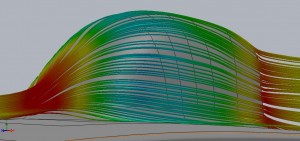While many other Bear Engineers were taking a break from the rigors of UC Berkeley during Winter Break, the CalSol Shell team was busy optimizing the aerodynamics of its latest car, Zephyr.

Since building a model for each iteration of the design would be incredibly costly, we use a software called Computational Fluid Dynamics (CFD) to simulate the conditions our car would encounter in the real world, such as turbulence and crosswinds. We model our car in SolidWorks, run CFD, analyze the results, and make the necessary modifications before starting the process over again, with each iteration taking about 5-7 days to complete.
Solar cars produce a fraction of the power of gasoline-powered vehicles, and consequently, it’s of paramount importance to have a well-designed body. We began the process in May 2012 by identifying the aerodynamic shortcomings of our previous car, Impulse. The aerodynamics team then spent the summer learning the intricacies of CFD and surface modeling by testing out numerous different airfoil bodies. Once we returned to Cal in the fall, we hit the ground running by splitting up our team into smaller subteams responsible for the design of different components of the car, like the wheel fairings, canopy, and airfoil body. Once we integrated all the different components, we began the nearly two-month process of running CFD and making changes to the aerodynamics.
To put our predicted performance values into perspective, Zephyr is 250% more aerodynamic than the Volkswagen Beetle, 182% more aerodynamic than the Toyota Prius, 133% more aerodynamic than the Ferrari California & McLaren, and 25% percent more aerodynamic than our previous solar car, Impulse.

We are pretty much done with the design of our new car and will be changing our focus to manufacturing in the coming weeks and months. Unfortunately, our predicted drag performance is, well, just that—predicted. Imperfections in manufacturing and real-world annoyances (splattered bugs) will inevitably increase our net drag. But our goal for this semester, as we begin the building process, is to minimize the number and impact of those imperfections as much as possible (bugs will still be bugs and splatter on our car).
